- What Exactly Is Co-Marketing?
- Why Do Brands Leverage Co-Marketing?
- Big Brand Co-Marketing Examples
- PepsiCo & Bungie
- Taco Bell & Fritos
- Examples of Online Co-Marketing Campaign
- Webinars
- eBooks
- Video Series
- Conferences
- Joint-Research
- Sprout Social’s Co-Marketing Results
- New Leads
- Revenue
- Partnerships
- How to Start Your Own Co-Marketing Program
- Moving Forward
Marketers fight an on-going battle to get products and services in front of target customers and prospective clients. Unfortunately, some of us are in incredibly competitive industries. We battle each day for things like impressions, shares and clicks.
If we want to succeed in reaching our audiences, we must explore new channels. One amazing way is to create strategic marketing alliances with other companies to help elevate your content and increase the reach of your campaigns. It’s an idea known as co-marketing.
Bạn đang xem: co-marketing là gì
What Exactly Is Co-Marketing?
Co-marketing is the process of building strategic relationships with other entities, typically separate companies or organizations relevant to your own. This marketing strategy is used to help you increase your brand’s overall reach. It’s the idea of calling in reinforcements and working together to help expose both brands to new audiences in order to drive additional product awareness, leads and revenue.
While co-marketing isn’t a new idea, it has grown in popularity in the online marketing world. So if you plan to implement your own program, keep reading this guide to make sure you know everything that goes into it.
Why Do Brands Leverage Co-Marketing?
The reasoning behind co-marketing is fairly straight-forward: there are organizations out there adjacent to yours. This means these businesses have similar customers without having a competitive offering. You can work with them to create a marketing campaign that will be promoted to both audiences. In this sense, you’re exposing both brands to audiences with proven purchase intent and a need for each product.
For example, we know that Sprout Social is a social media management platform for businesses. We also know that marketers who use a social media management solution may also leverage a search engine optimization solution. So it stands to reason that we may have a similar audience to a company that offers one, a company like Moz.

By creating a webinar with our good friends at Moz and promoting it to both audiences, we’re generating leads for both companies that our marketing and sales departments can go on to nurture. This boosts the webinars reach beyond what we could have done by ourselves.
Big Brand Co-Marketing Examples
The rest of this article really addresses how companies can leverage co-marketing in the online space with things like eBooks and webinars. But here are a few additional examples that show how big brands have leveraged their peer organizations in the past:
PepsiCo & Bungie
Since March of 2007, Pepsi Cola Inc. leveraged their new Mountain Dew flavor Game Fuel to help co-promote the release of new video games. This is a very clear brand tie-in, as Mountain Dew is fairly synonymous with video game playing. Here’s a look at their first run with Bungie’s Halo 3.

Đọc thêm: Từ Marketing 1.0 đến 4.0 – Những kiến thức cần biết để không lạc trôi giữa thời đại số
Game Fuel scaled this strategy by reaching out to other gaming companies to help promote new releases. They even created a second flavor for their 2009 run with the popular online game World of Warcraft.

Taco Bell & Fritos
A more recent example you may be familiar with comes from Taco Bell and Frito Lay. The companies teamed up to create new Taco Bell menu items like a burrito with Frito chips inside or a taco with a Dorito shell.

These companies both went on to co-promote the new items with commercials, articles and social media content. This ultimately drove new business for both brands.
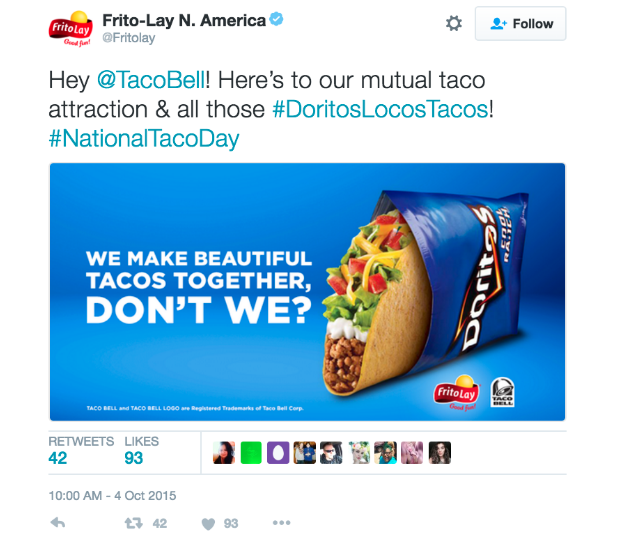
Examples of Online Co-Marketing Campaign
While these campaigns have all been well thought-out and successful, they’re not what you’ll typically see when online marketers reference co-marketing (at least not with the companies we’ve worked with). While dealing with co-marketing in the tech space, you’re much more likely to see companies come together to work on pieces of content.
Webinars
Joint webinars are one of the easiest ways to scale your partner marketing efforts if you have someone on the team great at creating and delivering presentations.

There are some additional things to know when building out your webinar infrastructure for scale. For example, you need:
- A solid company outreach strategy to find great companies to work with.
- A way to update landing page logos and copy quickly. Try a tool like Unbounce.
- The ability to create promotional assets, like the social media image you see above or an email template.
eBooks
eBooks are great at driving qualified leads, as those downloading your asset are committed to spending a good deal of effort learning what you have to teach them.
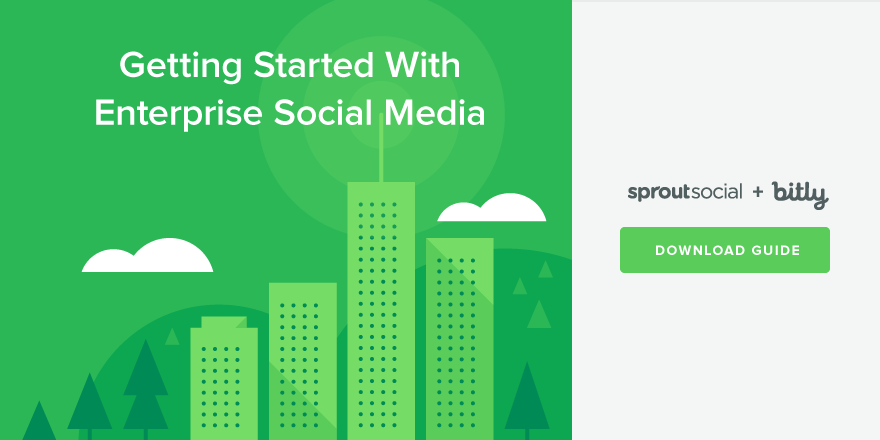
However, creating the robust copy you need for an eBook and getting it designed nicely takes a lot of effort. Make sure you test eBooks and see if they drive qualified leads at scale for your company before you commit to making several.
Video Series
If you have the resources to create a video series, it’s an amazing way to produce content with another company. Videos continue to increase in social media popularity, and with the joint power of two companies sharing, you’re bound to build a good amount of brand awareness.

Conferences
Đề xuất riêng cho bạn: Hot Lead là gì? 3 Loại lead quan trọng marketer nào cũng biết
Conferences are a great way for several companies to band together for a single campaign all at once. Most large conferences facilitate sponsorships from multiple companies. This creates a mini-ecosystem of companies that benefit from working together.

Joint-Research
Data reports like the Sprout Social Index are an incredibly powerful type of content to share. Research-driven content gains social shares, backlinks and high-praise. If you can figure out a way to combine the data you have with data from a partner, it can tell a more compelling story.
Sprout Social’s Co-Marketing Results
Since taking a dive into co-marketing, Sprout Social has seen fantastic results by driving new leads, product trials, demos, subscribers and overall revenue. Not only that, but we’ve had the opportunity to work with amazing companies that are now more aware of our product offering.
New Leads
This is one of the key metrics for our program. Over the course of the program, we’ve driven around 25,000 new leads through co-marketing efforts. And this number continues to scale as we fine-tune our processes. For the most part, these leads come to us without having to spend any money on promotion.
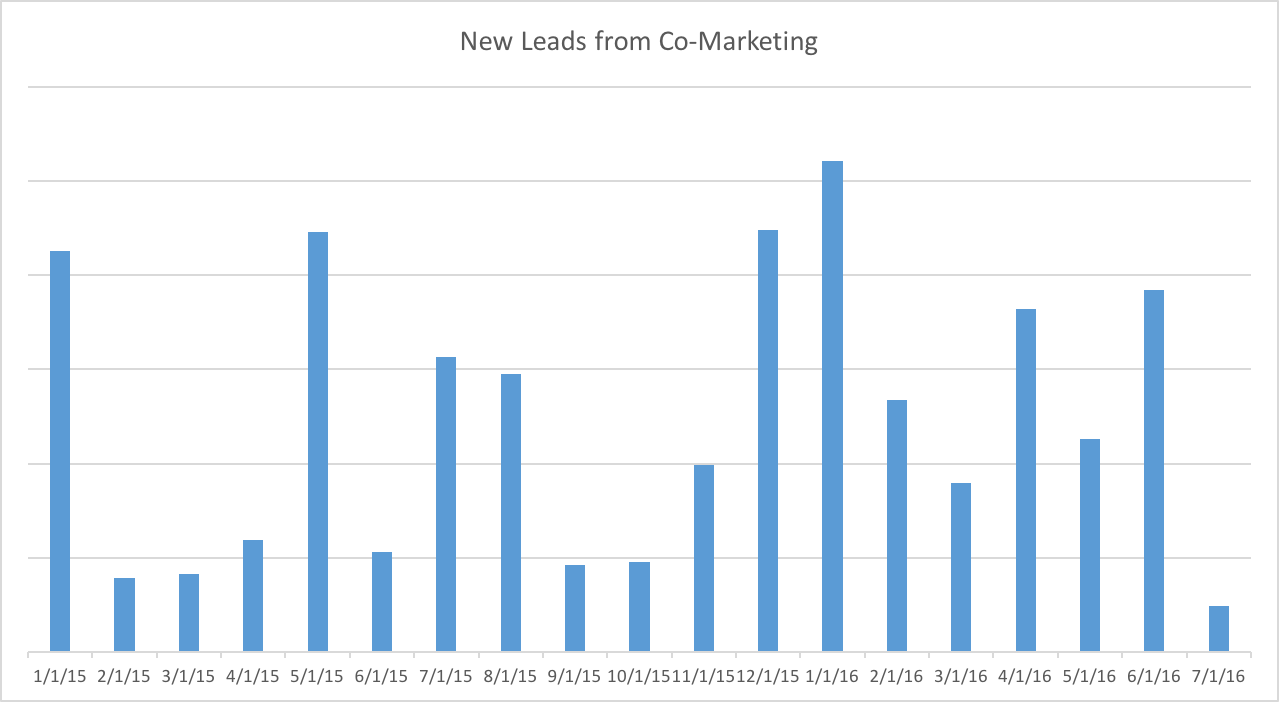
Revenue
Not only is co-marketing good for driving new leads, it’s great for educating customers on the value of our product. That’s why we find leads from these efforts convert at a much higher rate. In fact, these leads end up spending more money than leads from any other channel.
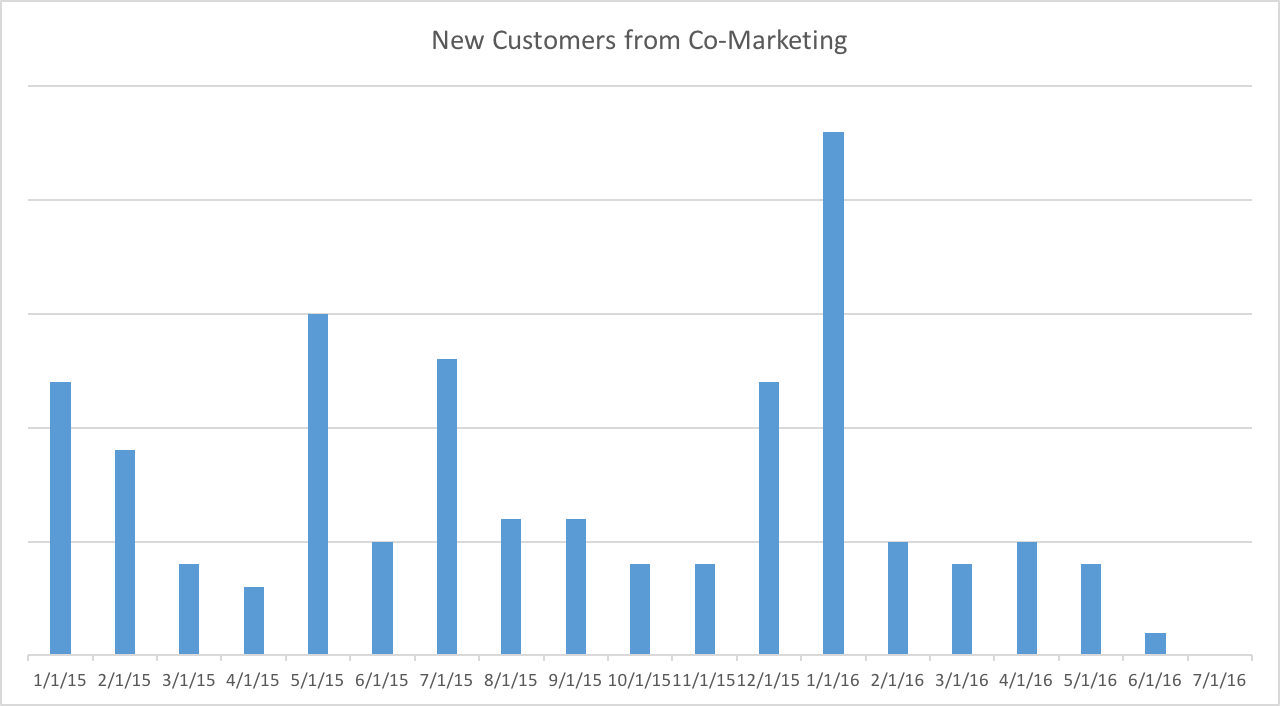
Partnerships
Throughout the course of our co-marketing efforts, we’ve had the opportunity to work with more than 40 new companies. These are 40 large, relevant companies that are now much more aware of what we do at Sprout Social. So whether these businesses chat with one of their own clients who might need more information on a social media management tool, or they themselves are in the market, we have a new arsenal of brand advocates.
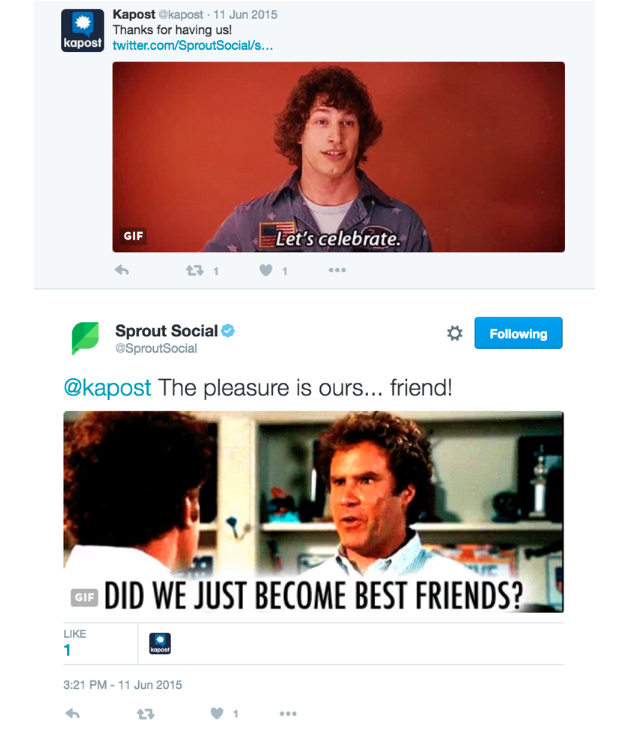
How to Start Your Own Co-Marketing Program
Each company’s co-marketing program and execution differs. The strategy that works for us may not completely work for you. While this isn’t an extensive guide to launching your own program, it should start you off in the right direction.
- Set an Objective: Similar to any other marketing campaign the first thing you need to do is set an objective. Are you looking to educate your own customers, build your brand awareness or generate leads? This knowledge will help inform what types of companies you work with and what types of content you create.
- Reach out to Companies: Find some companies you believe have similar audiences and objectives to your own. Send them an email proposing why you think you’d be a good fit for co-marketing. Also be sure to include the value they would gain and ask to set some time aside to chat for more details.
- The Initial Call: When you have your first call, it’s important to figure out if you’re attempting to reach the same audience. You don’t want to spend a ton of time and effort on a campaign that doesn’t reach your target. Once you’ve established an audience fit, think through the topics both companies can speak to that resonate with that audience. Then you can choose a type of content to create like an eBook, webinar or video series. Create hard deadlines for each side so you’re effectively keeping up with the campaign across organizations.
Moving Forward
The initial call should set the stage for the rest of the campaign. Make sure that you’re hitting all of the deadlines and producing truly amazing content that your joint audience will love and your results should speak for themselves.
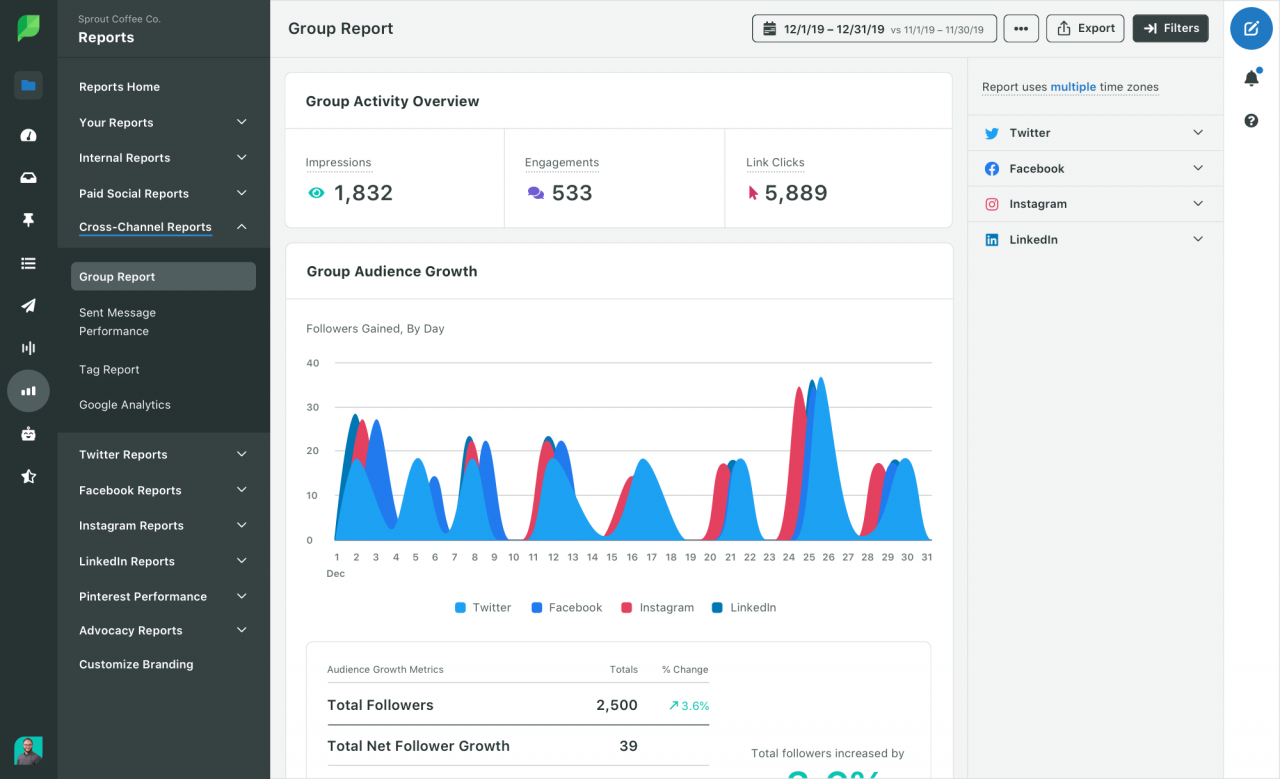
If you’re planning a co-marketing social media strategy, make sure you have the right social media analytics tools to track, monitor and measure your own efforts. Having statistical data and presentation-ready reports can help push your co-marketing efforts to the next level.
It’s a big marketing world out there and it never hurts to have some helpful allies.